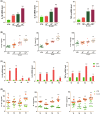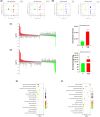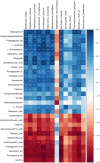Baogong decoction treats endometritis in mice by regulating uterine microbiota structure and metabolites
- PMID: 35932174
- PMCID: PMC9618315
- DOI: 10.1111/1751-7915.14127
Baogong decoction treats endometritis in mice by regulating uterine microbiota structure and metabolites
Abstract
Endometritis is persistent inflammation caused by bacteria, which can lead to infertility. Although traditional Chinese medicine (TCM) has been used to treat endometritis, the underlying mechanism is still unclear. Here, Baogong Decoction (BGD), a TCM compound, was used to treat mouse endometritis induced by Escherichia coli (E. coli), and then 16S rRNA sequencing and non-targeted metabolomics were used to investigate the change of uterine microbiota and metabolomes in serum and uterine after BGD treatment. Finally, the therapeutic effect of potential metabolites for treating mouse endometritis screened by combined omics analyses was verified using pathological model. The results showed that BGD treatment could effectively treat endometritis associated with the increasing relative abundance of Firmicutes, Bacteroides, Lactobacillus and Lactococcus, and the decreasing relative abundance of Cupriavidus and Proteobacteria. 133 and 130 metabolites were found to be potential biomarkers in serum and uterine tissue respectively. In serum and tissues, dehydroepiandrosterone (DHEA) and catechol were significantly increased in the BGD treatment versus the inflammation group. Results of combined omics analyses demonstrated that DHEA was positively correlated with changes in microbiota. Results of pathological model demonstrated that DHEA could cure endometritis effectively associated with the decreasing infiltration of inflammatory cells and expression of inflammatory factors in the uterus. In summary, our results demonstrated that BGD could cure endometritis in mice by modulating the structure of the uterine microbiota and its metabolites, in which DHEA may be one of the main components of the therapeutic effect of BGD.
© 2022 The Authors. Microbial Biotechnology published by Society for Applied Microbiology and John Wiley & Sons Ltd.
Conflict of interest statement
The authors declare no conflict of interest.
Figures






Similar articles
-
Uterine Tissue Metabonomics Combined with 16S rRNA Gene Sequencing To Analyze the Changes of Gut Microbiota in Mice with Endometritis and the Intervention Effect of Tau Interferon.Microbiol Spectr. 2023 Jun 15;11(3):e0040923. doi: 10.1128/spectrum.00409-23. Epub 2023 Apr 17. Microbiol Spectr. 2023. PMID: 37067455 Free PMC article.
-
The alteration of intrauterine microbiota in chronic endometritis patients based on 16S rRNA sequencing analysis.Ann Clin Microbiol Antimicrob. 2023 Jan 12;22(1):4. doi: 10.1186/s12941-023-00556-4. Ann Clin Microbiol Antimicrob. 2023. PMID: 36635729 Free PMC article.
-
Protective Effect of Clostridium butyricum on Escherichia coli-Induced Endometritis in Mice via Ameliorating Endometrial Barrier and Inhibiting Inflammatory Response.Microbiol Spectr. 2022 Dec 21;10(6):e0328622. doi: 10.1128/spectrum.03286-22. Epub 2022 Nov 2. Microbiol Spectr. 2022. PMID: 36321897 Free PMC article.
-
Symposium review: The uterine microbiome associated with the development of uterine disease in dairy cows.J Dairy Sci. 2019 Dec;102(12):11786-11797. doi: 10.3168/jds.2019-17106. Epub 2019 Oct 3. J Dairy Sci. 2019. PMID: 31587913 Review.
-
Relevance of assessing the uterine microbiota in infertility.Fertil Steril. 2018 Aug;110(3):337-343. doi: 10.1016/j.fertnstert.2018.04.041. Fertil Steril. 2018. PMID: 30098680 Review.
Cited by
-
Genetically predicted the causal relationship between gut microbiota and infertility: bidirectional Mendelian randomization analysis in the framework of predictive, preventive, and personalized medicine.EPMA J. 2023 Jul 7;14(3):405-416. doi: 10.1007/s13167-023-00332-6. eCollection 2023 Sep. EPMA J. 2023. PMID: 37605651 Free PMC article.
-
Mechanistic Study on the Alleviation of Endometritis in Mice Through Inhibition of NF-κB and MAPK Signaling Pathways by Berberine and Carvacrol.Microorganisms. 2025 Apr 30;13(5):1051. doi: 10.3390/microorganisms13051051. Microorganisms. 2025. PMID: 40431224 Free PMC article.
-
Identification and validation of key target genes of penning formula for treating rat chronic endometritis model.Sci Rep. 2025 Jul 1;15(1):22358. doi: 10.1038/s41598-025-02585-9. Sci Rep. 2025. PMID: 40592989 Free PMC article.
-
Causal relationships between gut microbiota and male reproductive inflammation and infertility: Insights from Mendelian randomization.Medicine (Baltimore). 2025 Apr 25;104(17):e42323. doi: 10.1097/MD.0000000000042323. Medicine (Baltimore). 2025. PMID: 40295237 Free PMC article.
-
Ningxin-Tongyu-Zishen formula alleviates the senescence of granulosa cells on D-galactose-induced premature ovarian insufficiency mice.Aging (Albany NY). 2024 Feb 28;16(5):4541-4562. doi: 10.18632/aging.205607. Epub 2024 Feb 28. Aging (Albany NY). 2024. PMID: 38428403 Free PMC article.
References
-
- Aldridge, K.E. & Sanders, C.V. (2002) Susceptibility trending of blood isolates of the Bacteroides fragilis group over a 12‐year period to clindamycin, ampicillin‐sulbactam, cefoxitin, imipenem, and metronidazole. Anaerobe, 8, 301–305. - PubMed
-
- Alexaki, V.I. , Fodelianaki, G. , Neuwirth, A. , Mund, C. , Kourgiantaki, A. , Ieronimaki, E. et al. (2018) DHEA inhibits acute microglia‐mediated inflammation through activation of the TrkA‐Akt1/2‐CREB‐Jmjd3 pathway. Molecular Psychiatry, 23, 1410–1420. - PubMed
-
- Bicalho, M.L.S. , Santin, T. , Rodrigues, M.X. , Marques, C.E. , Lima, S.F. & Bicalho, R.C. (2017) Dynamics of the microbiota found in the vaginas of dairy cows during the transition period: associations with uterine diseases and reproductive outcome. Journal of Dairy Science, 100, 3043–3058. - PubMed
Publication types
MeSH terms
Substances
LinkOut - more resources
Full Text Sources

